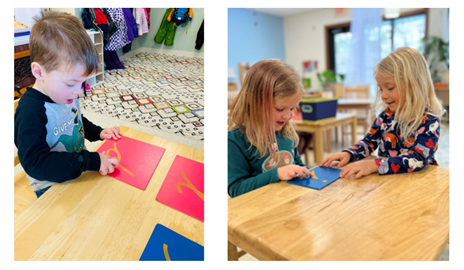Handwriting, The Montessori Approach
In an authentic Montessori Program, your 3 to 6-year-old child will be introduced to cursive writing. While many view cursive penmanship as a relic of the past, there is much to be valued in learning it, especially for emerging writers.
Handwriting Can Save Your Brain
In this article entitled "7 Ways Writing by Hand Can Save Your Brain." Dr. Marc Seifer, a graphologist and handwriting expert shares some of the many ways that writing by hand helps the brain. Writing is important for both the developing child and at any age.
Key benefits or handwriting are:
It has a calming effect.
It coordinates between both sides of the brain.
It boosts cognitive skills.
It inspires creativity.
It sharpens aging minds.
It improves memory.
It uses more of your brain than typing.
Handwriting in Montessori
In Montessori Schools, we understand the importance of handwriting, and in particular writing in cursive. We do not teach cursive simply for the aesthetic beauty, but also for the following reasons :
Natural Movement
Cursive is a more natural movement of the hand and easier for the very young child to form the continuous flow of the letter. For example, look at the way the young child draws. Children most often draw circles, curves, and squiggly lines.
Eliminates Reversals
Cursive Letters help eliminate reading and writing reversals such as "b" and "d" since the cursive forms of these letters are each very distinct. In addition, lower case and upper-case cursive letters are different from each other in almost all cases.
Transition to Print
Children quickly make the transition from reading cursive to reading print. However, children who only learn print are more than likely not able to read cursive.
Easier for the Hand
Printing is tedious, more physically tiring for the hand, and spatially confusing. In cursive, the child does not have to lift the pencil until the word is finished. The movement is one continuous flow and direction. This continuity of cursive indirectly prepares for the process of reading.
Art of Handwriting
Some might say, "Why teach cursive when books, signs, etc. are all written in print?" But cursive is not taught to aid the child in reading books or other materials, but rather to teach them the beautiful art of handwriting and self-expression.
Sandpaper Letters
We present the letters to the young child, beginning around age 3, using Sandpaper Letters. Using multiple senses to learn the letters helps the child remember them better and makes the process of learning cursive easy and enjoyable. Learning cursive later in life is much more challenging and not as enjoyable.
Sand Tray
Once the child is able to trace many of the Sandpaper Letters accurately, they can begin to write the letters in the Sand Tray.
Movable Alphabet
Once a child knows most of the letter sounds through their work with the Sandpaper Letters, they start to work with Movable Alphabet where they sound out words and place the corresponding letters to "write" words. With this material children can start expressing themselves with written words before their hands may be ready to actually write.
Writing Letters
Children then begin practicing writing cursive letters on chalkboards and paper called "writing strips."
Writing Words
After lots of work with writing strips to practice the mechanics of writing, and lots of work with the Movable Alphabet to sound out words, the child puts that knowledge together to write and illustrate words on paper.
Painted Map and Flag Drawing
When a child knows the names of all the continents, they may learn to make a world map where they can trace, paint, and label all of the continents, using beautiful cursive writing. Children can also write the name of a country and draw a picture of the corresponding flag.
Sentence Writing and Story Writing
This child is expanding their knowledge of writing words and joining them together to write a sentence and illustrate it. Later children will write many sentences together to make a story or even a research paper!
Some people may say handwriting is a dying art, but here at WBMS we are keeping this work of art alive on a daily basis!









